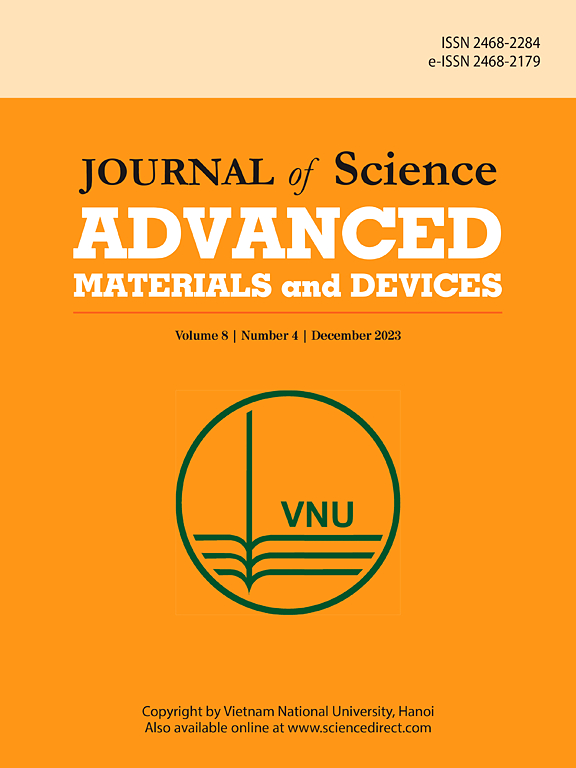Unveiling the potential of decorating tunable morphology of bismuth sulfide nanostructures on the Bi2WO6 nanosheets for enhanced photoelectrochemical performance
IF 6.7
3区 材料科学
Q1 MATERIALS SCIENCE, MULTIDISCIPLINARY
Journal of Science: Advanced Materials and Devices
Pub Date : 2024-10-10
DOI:10.1016/j.jsamd.2024.100800
引用次数: 0
Abstract
In this study, we used different sulfur sources (thiourea and sodium sulfide) in the hydrothermal vulcanization to create two types of Bi2S3/Bi2WO6 composite materials with different structures. We varied the vulcanization duration to control the degree of vulcanization of the samples. The composites made with sodium sulfide displayed a mix of particles and nanosheets, while those made with thiourea showed nanowires and nanosheets. The choice of sulfur source had a significant impact on the structural characteristics of the composite material. In photoelectrochemical experiments (PEC), the vulcanization-treated Bi2S3/Bi2WO6 composites improved significantly compared to the pristine Bi2WO6 template. In particular, the Bi2S3/Bi2WO6 composite prepared using sodium sulfide precursor for 4 h exhibited the best photocurrent density and the lowest charge transfer interface resistance. The improved performance is attributed to the suitable defect density and a Z-scheme mechanism facilitated by the built-in electric field at the interface, which effectively separated photogenerated carriers, increasing active species and significantly improving the composites' efficiency in PEC reactions.
揭示在 Bi2WO6 纳米片上装饰可调硫化铋纳米结构形态的潜力,以提高光电化学性能
在本研究中,我们在水热硫化过程中使用了不同的硫源(硫脲和硫化钠),从而制备出两种具有不同结构的 Bi2S3/Bi2WO6 复合材料。我们改变硫化持续时间来控制样品的硫化程度。用硫化钠制成的复合材料显示出颗粒和纳米片的混合结构,而用硫脲制成的复合材料则显示出纳米线和纳米片的混合结构。硫源的选择对复合材料的结构特性有重大影响。在光电化学实验(PEC)中,硫化处理过的 Bi2S3/Bi2WO6 复合材料与原始 Bi2WO6 模板相比有显著改善。特别是,使用硫化钠前驱体硫化 4 小时制备的 Bi2S3/Bi2WO6 复合材料表现出最佳的光电流密度和最低的电荷转移界面电阻。性能的提高归功于合适的缺陷密度和界面内置电场促进的 Z 型机制,它们有效地分离了光生载流子,增加了活性物种,显著提高了复合材料在 PEC 反应中的效率。
本文章由计算机程序翻译,如有差异,请以英文原文为准。
求助全文
约1分钟内获得全文
求助全文
来源期刊

Journal of Science: Advanced Materials and Devices
Materials Science-Electronic, Optical and Magnetic Materials
CiteScore
11.90
自引率
2.50%
发文量
88
审稿时长
47 days
期刊介绍:
In 1985, the Journal of Science was founded as a platform for publishing national and international research papers across various disciplines, including natural sciences, technology, social sciences, and humanities. Over the years, the journal has experienced remarkable growth in terms of quality, size, and scope. Today, it encompasses a diverse range of publications dedicated to academic research.
Considering the rapid expansion of materials science, we are pleased to introduce the Journal of Science: Advanced Materials and Devices. This new addition to our journal series offers researchers an exciting opportunity to publish their work on all aspects of materials science and technology within the esteemed Journal of Science.
With this development, we aim to revolutionize the way research in materials science is expressed and organized, further strengthening our commitment to promoting outstanding research across various scientific and technological fields.
 求助内容:
求助内容: 应助结果提醒方式:
应助结果提醒方式:


